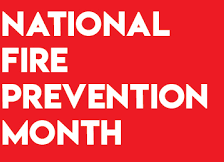October is Fire Prevention Month and the National Fire Prevention Association hopes everyone will set aside time to learn about fire prevention and safety and plan and practice an escape in case of a fire.
Tips for added safety:
-
-
- From the time the smoke alarm sounds, you and your family may have only a minute or two to escape.
- Plan an escape route for your family and set up an outside meeting place a safe distance from the home.
- Learn two ways out of every room. Be sure all doors and windows leading outside open easily and are free of clutter.
- Look for places fire could start. Identify fire hazards and take care of them.
- Concentrate on education. Talk with your whole family about fire safety.
- Each floor and all bedrooms should have a fire alarm and carbon monoxide detector. Batteries should be checked monthly.
-
Statistics:
-
-
- Three of five home fire deaths happened in homes with no working smoke alarms.
- Carbon monoxide is the No. 1 cause of accidental death but only 47 percent of people report having CO alarms in their home.
- Only 43 percent of homeowners have an escape plan.
- Take all necessary precautions when cooking as the kitchen is the primary area where fires start.
- Keep a fire extinguisher on each floor and in the kitchen and garage.
-
Older adults and individuals with physical or mental disabilities face the greatest relative risk of dying in a fire. Older adults had a 2.7 times greater risk of dying in a fire than the total population. Ages 85 and over were 3.8 times more likely to die in a fire than the total population.
Disabilities or age do not prevent you from staying safe. In addition to the suggestions above, there are specific things older people and people with disabilities can do to stay safe.
-
-
- Build your home safety plan around your abilities.
- Smoke alarms with a vibrating pad or flashing light are available for people with hearing or sight problems. Install smoke alarms with a strobe light outside to alert neighbors.
- If you are not able, ask someone to test smoke alarm batteries every month and change them at least once a year.
- The safest place in an apartment building is on the ground floor. If you live in a multistory home, arrange to sleep on the first floor. Being on the ground floor and near an exit will make escape easier.
- Plan escape around your abilities and know at least two exits from every room.
- If you use a walker or wheelchair, check exits to be sure you can get through the doorways.
- Make changes including installing exit ramps and widening doorways, to make escape easier.
- Speak to family members, building manager or neighbors about your fire safety plan and practice it with them.
- Contact your fire department’s non-emergency line and explain your needs. They can suggest escape plan ideas and might perform a home fire safety inspection if you ask.
- Ask emergency providers to keep your needs information on file.
- Keep a phone near your bed and be ready to call 911 if necessary.
-
Sources: Firstalert.com, nfpa.org, Usfa.fema.gov


